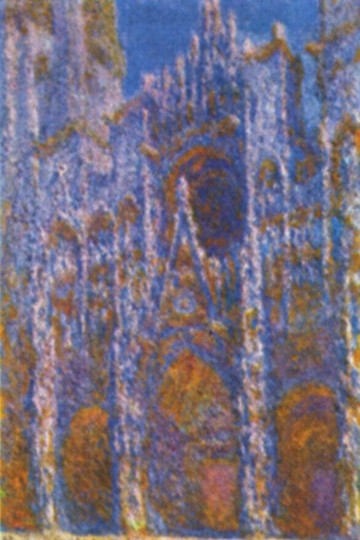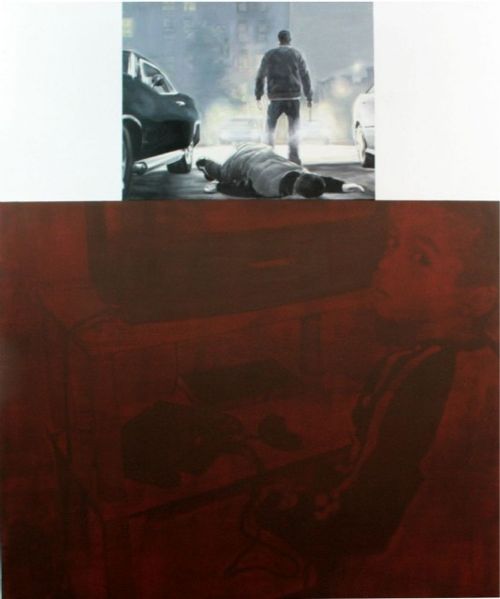The freedom to explore all of a game’s territory is one of the keys to the success of the Grand Theft Auto (GTA) series from Rockstar Games. The first game in the series was released 1997. Since then, ten stand-alone games and four expansion packs has been produced for PC consoles and Xbox and Playstation devices. It’s not only the players that love the freedom of the game’s storyline–many artists have been attracted to GTA’s virtual world and are inspired to explore it further, in their own ways. GTA is a good example how artists today are using different techniques to appropriate commercial videogames for works of art.
But first, I think I need to make a distinction between fan art and game art. As in many popular cultures, there is a lot of fan art connected to videogames that is created by dedicated players. That art can take the form of paintings, stories, videos and so on. But fan art is often only a reproduction of an existing game world. The fan artists are mimicking the aesthetic of the games and are following certain templates created by the fan community. Game art, on the other hand, experiments with and challenges the image and the idea of what a game can be. It can borrow the aesthetic of the game, but it is often critical of that aesthetic. The artists use the game as a platform or interface to explain and explore larger questions of gender, violence, and economic and social realities that are played out in the game world.

Claude Monet. “The portal and the tower of the saint-romain at morning sun, Harmony in Blue,” 1893. Collection Musee D’Orsay, Paris.
One artist that has taken a critical view on the Grand Theft Auto series is the American Joan Pamboukes. In The Enclosed Landscapes series Pamboukes works with C-prints to create impressionist-style landscapes. The pictures are unfocused, with a limited color scale, and in some ways evoke Claude Monet’s Rouen Cathedral series, which explored how the light changed on a church façade during the day. In Pamboukes’s case, she raises the question of why the landscapes in videogames such as GTA are so beautiful, in contrast to the ugly violence of the story. On her website, the artist states that “I find it ironic that these beautifully serene landscapes were designed to house horrid simulations of unspeakable and appalling violence—a world where thievery, murder, warfare, and prostitution are the order of the day. Mesmerized by these atmospheric digital surroundings, I intended to capture and re-emphasize this intangible, sublime, and fleeting reality,”
The South African artist and researcher Pippa Tshabalala has also worked with photography in her series Telling Death. Here, Tshabalala documented the deaths of different characters in Grand Theft Auto, and asked players to invent stories to explain how they died. Like many other works of game art, Telling Death explores the virtual violence and deaths gamers experience in virtual worlds. The project involves the gaming community, and asks participants to contribute fictional stories about the characters in a way that is also reminiscent of fan art.
It’s also becoming common for artists to use videogames as a motif for paintings. (My blog post on Kristoffer Zetterstrand is one example of how artists are transferring the digital image to a canvas). Another example is the Italian artist Stefano Spera. His 2009 oil painting Grand Theft Auto is part of a series of paintings that documents the fictional world of pixels. On the painting’s first panel we see a screen with a violent screenshot from GTA, and on the other panel, a child playing the game itself. In this painting Spera is playing with the contrast between the real and the virtual worlds, and the innocent child and the violent society of adults.
Many virtual game worlds let you experience characters, environments, and situations that you would never be able to experience in normal life. For that purpose, the Finnish painter Petri Hytönen spent a year immersed in the virtual world of Grand Theft Auto looking for new inspiration for his art. The results was GTA-SAGA, a series of thirty large-scale watercolors with motifs and situations collected from GTA.
[vimeo:https://vimeo.com/13675663]
If you think paintings sound a bit anachronistic, I can comfort you that there is also many example of artists usisng newer expressions like machinima. In the past few years machinima have become more and more common among artists exploring the world of videogames. Myfanwy Ashmore, an American artist, has created the video Grand Theft Love Song (see above) where the main GTA character Nico Bellic is made to dance in his safehouse. In some ways, the video disarms the violent character by turning him into a puppet forced to dance to the 1927 song Creole Love Call. David Borawski has also created a machinima based on the world of GTA. He describes the 2009 video Burn Out/Erased by the First Rain on the work’s Vimeo page thusly:
“Burn Out/Erased by the First Rain is comprised of two sequences staged and recorded from within the game GTA – San Andreas. The virtual biker does an extended circular burn out, using the motorcycle’s image of freedom and rebellion as a starting point, yet alluding to the repetition and futility of contemporary society.”
[vimeo:https://vimeo.com/15823124]
As you can see, there are numerous ways in which videogames are used and appropriated by artists today. Grand Theft Auto is only one example out of many. The most famous games have been used as sources–from classics like Pong and Space Invaders to newer games like The Sims and America’s Army. If you are interested in reading further on videogame appropriation in contemporary art, you can read some previous articles I wrote on the topic in this series, published on Furtherfield.






Pingback: Halvard Halvorsen’s tumblelog » Videogame Appropriation in Contemporary Art: Grand Theft Auto (GTA) | Art21 Blog